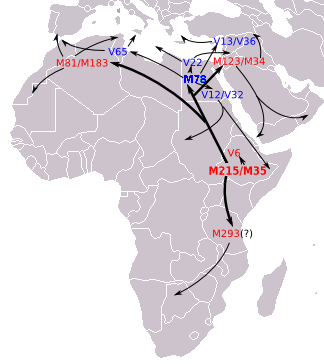"Tounge" is spelled tongue.
https://en.wikipedia.org/wiki/Haplogroup_E-M215_(Y-DNA)E-M215
E1b1b is M215 on this map.
"Haplogroup E1b1b (formerly known as E3b) represents the last major direct migration from Africa into Europe. It is believed to have first appeared in the Horn of Africa approximately 26,000 years ago and dispersed to North Africa and the Near East during the late Paleolithic and Mesolithic periods. E-M78 and E-Z827 originated respectively at 20,000 years and 24,000 years. E1b1b lineages are closely linked to the diffusion of
Afroasiatic languages.
Lazaridis et al. (2016) tested the first ancient DNA samples from the Mesolithic
Natufian culture in Israel, possibly the world's oldest sedentary community, and found that the male individuals belonged either to haplogroups CT or E1b1 (including two E1b1b1b2 samples). These are to date the oldest known E1b1b individuals. The same haplogroups show up in Pre-Pottery Neolithic B Jordan, accompanied by new haplogroups (H2 and T). Besides, E1b1b was not found in Neolithic Iran or Anatolia, and only showed up twice among the hundreds of Neolithic European samples that have been tested. This evidence suggests that at the end of the last glaciation 12,000 years ago, E1b1b men were present in the Levant, but not in other parts of the Near East. There is evidence that the Natufians already cultivated cereals like rye before the Neolithic period. Cereal farming may therefore trace its roots (literally) to the E1b1b tribes of the Mesolithic Levant.
Nowadays, the highest genetic diversity of haplogroup E1b1b is observed in Northeast Africa, especially in Ethiopia and Somalia, which also have the monopoly of older and rarer branches like M281, V6 or V92. This suggests that E1b1b may indeed have appeared in East Africa, then expanded north until the Levant. Nevertheless, many lineages now found among the Ethiopians and Somalians appear to have come from the Fertile Crescent during the Neolithic period. This includes some E1b1b subclades like V22 (12,000 years old) and V32 (10,000 years old), but also undeniably Near Eastern lineages like T1a-CTS2214 and J1-L136."
E1b1b (E-M215) arrived in Somalia, along with M-35, along the route up the Nile from Kush in the Sudan, to the southeastern Ethiopian highlands or Lake Turkana, and from there east and north into Somalia. Interestingly, Somalis tested in northern Kenya were 100% E1b1b, while Somalis in Djibouti were only 25%. 66.7% of Somalis in northern Kenya were E-V-32, but only 25% of Djibouti Somalis. So there is a clear spectrum from "E" to "T", even with the recent migrations south of northern Somali clans. As the dude says, T1a-CTS2214 is "undeniably Near Eastern." It is not Cushitic.
Per Wikipedia, these are the references for the word "Cushite":
"Cushite may refer to :
Kindly note that the last four uses refer either to persons or to kingdoms and cultures. Kush was a recipient of the Natufian agriculture and eventually provided the language and peoples for the Cushitic migrations that populated the Horn. I am just sad for you if you can't make that connection.



